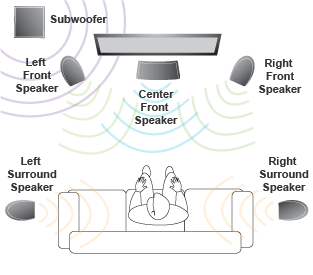After a tiring day at work and sustaining long hours of being stuck in a traffic, one often wishes to come home back to some entertainment and enjoy the rest of the day with family.
What else could be a better form of entertainment other than viewing one's favourite web series or a movie with a captivating story line? Alas, the entire immersive experience one wishes to have when viewing content gets subdued when one does not have the auditory hardware to accompany one's wishes. To have a surround, 3-Dimensional sound that seems to be emanating from all the corners of the room, it is imperative to invest on a sound system.
These are primarily offered in three configurations - a 5.1 channel home theatre system, a Sound Bar and a 2.1 channel speaker setup.
- 5.1 channel home theatre setup
- Two channels in the front(left and right)
- Two channels at the rear(left and right)
- One channel at the center
- One sub-woofer
Now, coming to the front left and right speakers. Most of the music and sound effects in a soundtrack are produced by this set of speakers. So, the background score one relishes in a movie are a work of the front left and right speakers. These two speakers are also used for dialogue reproduction when the voices move from right towards the left of the screen and vice-versa.
On the other hand, the rear left and right speakers are used to complement and accentuate the music and sound effects in a soundtrack produced by the two front speakers. The rear channels are meant to give a surround sound effect to the audio produced and thereby make the listening experience all the way more immersive.
Now, coming to most audiophiles' favourite piece of equipment - the sub-woofer. A sub-woofer is dedicated to producing bass frequencies ranging from 20 Hz to 100 Hz. At such low bass frequencies, sounds produced are as much felt as they are heard. Thus, the sub-woofer provides the powerful audio rumble and punch which is now commonly found in movies, in particular for dramatic effects associated with explosions and sophisticatedly shot crashes.

While it would not be correct to use the word ‘substitute’ of home theatre systems to refer to the alternative sound system options, as a surround sound home theatre system is second to none. However, if one has constraints of space or if one does not want to deal with the web of wires that are associated with the home theatre system, oftentimes, the below mentioned sound system options become more desirable.
- A 2.1 Channel
Surround Sound Home Theatre System
https://amzn.to/3u1fXKr, https://amzn.to/3q2MZZd, https://amzn.to/3JcP4cB
2.1 Channel Sound System
https://amzn.to/35WRqOs, https://amzn.to/3Ik9LT2, https://amzn.to/3IeSXwm, https://amzn.to/3i7ckNg, https://amzn.to/3JqIuPO, https://amzn.to/36mWHyA, https://amzn.to/3u0Pht4
Sound Bar
https://amzn.to/3MRZzo8, https://amzn.to/3KFiCQs, https://amzn.to/3MNh2hD, https://amzn.to/3JdGnih, https://amzn.to/3tYp8v1, https://amzn.to/3CHvpPE, https://amzn.to/3w4d6TD, https://amzn.to/34LYYTQ





